Beyond free phishing protection: Why a true security awareness strategy matters
With over 20 years in cybersecurity, I've seen the industry change drastically in many ways. One thing that hasn't changed? Phishing remains one of the most persistent threats organizations face.
According to Verizon's latest Data Breach Investigations Report (DBIR), around 60% of breaches involve the human element, and in response, companies continue to hunt for solutions that protect their people and data.
The free phishing tool landscape
Many major tech vendors have gradually expanded their security portfolios to include basic anti-phishing measures. Your typical free or basic subscriptions offer fundamental protections like spam filtering and the ability to report suspicious emails. Premium subscriptions typically unlock more advanced features that scan and block malicious content before it reaches the employees' inboxes.
Strengthen security awareness with human risk management
Infosec HRM, powered by Right-Hand Cybersecurity, provides alert-based training nudges to minimize human risk at your organization. 
Some vendors even offer attack simulation training at higher tiers, enabling realistic phishing simulations using real-world lures with automated targeting and remediation. This represents the industry's acknowledgment that technical defenses alone aren't enough — human awareness is crucial.
The limitations of "free" solutions
If you don't have a security awareness training provider, these free tools are one place you can start; however, they offer limited benefits.
1. Access restrictions
The most robust phishing simulation and training capabilities are typically locked behind paywalls for premium plans. This creates a security gap where smaller organizations or those with budget constraints lack adequate protection.
This can lead to data breaches being more impactful for those smaller organizations. As the Verizon DBIR found, "Whereas large orgs see Ransomware only comprising 39% of the breaches, SMBs are experiencing Ransomware-related breaches to the tune of 88% overall. Speaking of adages, 'When it rains, it pours' comes immediately to mind."
2. Depth and customization
In addition, these tools only provide only baseline defense — they might catch obvious spam but lack the simulation-based learning or behavioral analytics needed for comprehensive awareness training. For example, they don't adequately address sophisticated phishing techniques or social engineering tactics that target specific industries or roles.
3. Cultural integration
While basic tools encourage proactive security, they don't fully address the need for tailored, industry-specific content or broader cultural change. Security isn't just about recognizing phishing — it's about building a comprehensive security mindset that extends beyond email threats.
Why comprehensive security awareness actually matters
Over the years, I've responded to too many incidents where organizations never rolled out a robust security awareness plan until after they were hit with a data breach. Effective security awareness should go beyond the ability to spot a suspicious email, but what comprises comprehensive security awareness — and differentiates it from a basic approach?
1. Behavior change, not just recognition
Recognizing phishing emails is important, but true security awareness focuses on changing behaviors across all aspects of digital interaction. This includes secure password practices, safe browsing habits, proper data handling and understanding social engineering tactics beyond email.
I recently worked on two cases where deepfake scams caused people to send large amounts of money to places it wasn't supposed to go. If I’ve seen several cases like that just in my own network, you can imagine how widespread some of these emerging threats have become. Truly addressing these risks means changing behavior.
Deepfakes and AI spoofing are becoming a more widespread problem for organizations of all sizes, as I explain in this episode of Infosec IQ's Hacker Headlines series.
2. Role-based training needs
Different roles face different security challenges. Executives are targets for whaling attacks, finance teams for business email compromise, and IT staff for sophisticated technical exploits. A one-size-fits-all approach completely misses these nuanced training needs. However, as we discovered in our recent human risk management report with Dark Reading, more than three out of 10 organizations use the same standardized training for all employees.
By tailoring security awareness training to specific roles, organizations can yield significantly better results.
 Data from the Infosec and Dark Reading report, Beyond security awareness training: The state of human risk management.
Data from the Infosec and Dark Reading report, Beyond security awareness training: The state of human risk management.
3. Building a security culture
Effective security requires building a culture where security becomes second nature. This involves regular reinforcement through various phishing simulations, content formats, leadership buy-in and making security relevant to both professional and personal life.
It also means tying training to real-world data. For example, some people perform great against phishing simulations and have a perfect risk score — but only for simulated emails. When we look at endpoint security logs, there may be malware all over the environment from that person's interactions. Creating true human behavior change requires having a culture of security, continually reinforcing that culture and measuring the impact against actual events at your organization.
Phishing simulations & training
![]()
The human risk management evolution
We're entering an era where traditional security awareness is evolving into human risk management. This approach integrates data from various security systems to create more accurate risk assessments, minimizing the potential for human bias while providing personalized, relevant security guidance.
As machine learning and AI continue to advance, these solutions will only improve. They will enhance the ability to analyze complex data and generate more effective security protocols. For example, AI can now identify unusual login patterns that might indicate credential theft, while machine learning models can detect when employees are bypassing security controls and provide targeted coaching. Some advanced systems can even monitor an employee's security posture across various apps and devices, creating a comprehensive risk score that adjusts training requirements based on their specific vulnerabilities.
Security awareness is evolving into human risk management, as I explain in this clip from a recent Infosec webinar.
Think about the typical organization today — they might have endpoint security logs showing that an executive regularly connects to public Wi-Fi, email security showing they're targeted by sophisticated phishing campaigns, and badge access systems indicating unusual physical access patterns. With human risk management, all this data aggregates into actionable insights rather than remaining siloed in separate systems, just like SIEMs revolutionized technical security monitoring.
Once upon a time, firewalls, intrusion detection, endpoint security and various logs were all independently managed. The work to correlate all those different logs became too much — that's why SIEMs were created. Human risk management will have a similar impact on the human side of security, making all that data, security awareness training and risk scoring significantly more valuable by bringing them closer together.
Finding the right solution
As organizations evolve from free tools to security awareness training to human risk management, there are a few things they should keep in mind:
- Comprehensiveness of content library: Seek platforms covering a wide range of topics from phishing to emerging threats like deepfakes, with scenarios relevant to your industry.
- Variety of learning formats: Look for diverse content types (videos, games, microlearning) to accommodate different learning styles and combat security fatigue.
- Role-based customization options: Ensure training can be tailored to specific job functions and risk profiles rather than one-size-fits-all approaches.
- Integration capabilities with existing tools: The solution should connect with your current security infrastructure to enable real-time coaching and accurate risk assessment.
- Quality of reporting and analytics: Beyond completion metrics, seek behavioral insights and trend analysis to identify vulnerabilities and measure actual security improvements.
- Level of client support and expertise: The best vendors partner with you to implement and continuously improve your program as threats evolve.
Remember that effective security awareness isn't a one-time event but an ongoing program that evolves alongside the threat landscape.
Phishing simulations & training
![]()
The bottom line
While free phishing protections provide a valuable first line of defense, they represent just one piece of a much larger security awareness puzzle. Organizations with a goal to reduce human risk need a holistic approach that changes behaviors, builds culture and provides measurable results.
To combat today's sophisticated threat landscape, comprehensive security awareness isn't just nice to have — it's essential for protecting your most valuable assets and maintaining trust with customers and partners.








